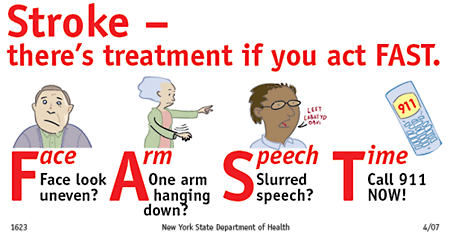Weather changes may be linked with stroke hospitalization, death
Stroke hospitalization and death rates may rise and fall with changes in environmental temperature and dew point, according to research presented at the American Stroke Association’s International Stroke Conference 2014.
“Weather is not something people would typically associate with stroke risk; however, we’ve found weather conditions are among the multiple factors that are associated with stroke hospitalizations,” said Judith H. Lichtman, Ph.D., M.P.H., study author and an associate professor in Epidemiology at the Yale School of Public Health in New Haven, Conn.
Researchers identified a nationwide sample of 134,510 people, 18 years and older, admitted to hospitals in 2009-10 for ischemic stroke (caused by a blood clot that blocks blood flow in or leading to the brain). They then obtained temperature and dew point data during that period.
They found:
Larger daily temperature changes and higher average dew point (indicating higher air moisture) were associated with higher stroke hospitalization rates.
Lower average annual temperatures were associated with stroke hospitalizations and death.
With each 1°F increase in average temperature, there was a 0.86 percent decrease in the odds of stroke hospitalization and a 1.1 percent decrease in the odds of dying in the hospital after stroke.
Increases in daily temperature fluctuation and average dew point were associated with increased odds of stroke hospitalization, but not with dying in the hospital.
 “This study suggests that meteorological factors such as daily fluctuations in temperature and increased humidity may be stressors that increase stroke hospitalizations,” Lichtman said. “People at risk for stroke may want to avoid being exposed to significant temperature changes and high dew point and, as always, be prepared to act quickly if they or someone they know experiences stroke signs and symptoms.
“This study suggests that meteorological factors such as daily fluctuations in temperature and increased humidity may be stressors that increase stroke hospitalizations,” Lichtman said. “People at risk for stroke may want to avoid being exposed to significant temperature changes and high dew point and, as always, be prepared to act quickly if they or someone they know experiences stroke signs and symptoms.
“Future research is needed to better understand the cause and effect of changes in weather conditions, as well as to explore potential mechanisms for this association.”
Stroke risk factors that can be changed, treated or controlled include: high blood pressure; cigarette smoking; diabetes; carotid or other artery disease; peripheral artery disease; atrial fibrillation; other heart disease; sickle cell disease; high blood cholesterol; poor diet; physical inactivity; obesity; and excessive alcohol consumption.
Stroke signs and symptoms are facial drooping, arm weakness, speech difficulty, sudden numbness or weakness of the leg, arm or face, sudden confusion or trouble understanding, sudden trouble seeing in one or both eyes, sudden trouble walking, dizziness, loss of balance or coordination, and sudden severe headache with no known cause.
###
 Co-authors are: Erica C. Leifheit-Limson, Ph.D., and Larry B. Goldstein, M.D. Author disclosures are on the abstract.
Co-authors are: Erica C. Leifheit-Limson, Ph.D., and Larry B. Goldstein, M.D. Author disclosures are on the abstract.
The study was funded by the Yale School of Public Health.
###
Statements and conclusions of study authors that are presented at American Stroke Association scientific meetings are solely those of the study authors and do not necessarily reflect association policy or position. The association makes no representation or warranty as to their accuracy or reliability. The association receives funding primarily from individuals; foundations and corporations (including pharmaceutical, device manufacturers and other companies) also make donations and fund specific association programs and events. The association has strict policies to prevent these relationships from influencing the science content.
Note: Actual presentation is 6:15 p.m. PT Wednesday, Feb. 12, 2014.
###
Karen Astle
.(JavaScript must be enabled to view this email address)
214-706-1392
American Heart Association